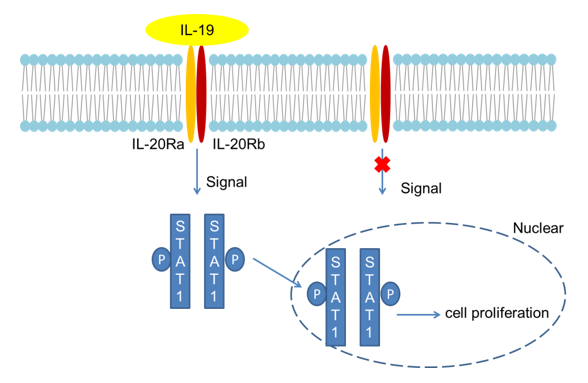Introduction
Interleukin-19 (IL-19) is a newly discovered cytokine of the interleukin-10 (IL-10) superfamily. It was first discovered and cloned by Gallagher in 2000. IL-10 is generally considered to be a cytokine that systematically inhibits inflammation, while IL-19 and IL-10 are similar in sequence and structure and both consist of 5 exons and 4 introns, so they were thought to be similar biological activity. IL-10 is an anti-inflammatory and anti-angiogenic cytokine, while IL-19 has dual immune effects of pro-inflammatory and anti-inflammatory, and also has biological effects such as promoting neo-angiogenesis and regulating the development of certain tumor diseases. However, it was later discovered that many studies have proved that the biological role of IL-19 is very different from IL-10, and it is widely expressed in a variety of cells and is involved in the occurrence and development of various inflammatory diseases. It plays an anti-inflammatory or pro-inflammatory role, and IL-19 also has different effects in diseases of different systems, especially in terms of inflammatory response.
Mechanism and Function
The IL-19 gene is located on human chromosome 1q32, and has 21% amino acid homology with IL-10. Its exon and intron structure is similar to human IL-10. And IL-19, IL-20, IL-22, and IL- 24 make up the IL-10 family. IL-19 is not only expressed in large amounts in human immune cells (monocytes, T / B lymphocytes, macrophages), but also plays an important role in immunoregulation, and even are highly expressed in tumor cells promoting tumor cell proliferation and metastasis. After IL-19 binds to the IL-20Ra / IL-20Rb heterodimer receptor complex, it exerts biological effects through signaling molecules such as STAT1 and STAT3, so IL-19 also belongs to the IL-20 subfamily. IL-19 can promote the polarization of lymphocytes and peripheral blood mononuclear cells (PBMC) to Th2. IL-19 promotes the Th2 immune response in the Th1 / Th2 immune balance, so IL-19 is first classified as a Th2 cytokine.
IL-19, as a new type of inflammatory factor regulating the immune system, is closely related to the occurrence and development of various diseases. In terms of vascular and intestinal inflammatory diseases, IL-19 mainly plays an immunosuppressive inflammatory response. In skin and respiratory tract autoimmune inflammatory diseases and certain tumor diseases, IL-19 mainly induces the expression of proinflammatory cytokines and chemokines in an autocrine or paracrine manner, and mediates tissue damage. However, the biological role of IL-19 is still not very clear. Even in unified tissues, it still exerts different immune functions under different body disease conditions. For example, endogenous IL-19 is involved in lung and airway antigen presenting cells' response to microbial and lung homeostasis, but IL-19 is involved in the pathogenesis of asthma. IL-19 plays an important role in the pathogenesis of autoimmune skin diseases, but IL-19 promotes skin wound healing by up-regulating the expression of keratinocyte growth factor (KGF) in fibroblasts. This seemingly contradictory biological effect of IL-19 is closely related to its powerful immunoregulatory activity, which also indirectly indicates that too little is known about the immune response function of IL-19.
Involvement of IL-19 in signal transduction is very complicated. Its biological functions are different in different environments and different cells. It participates in the pathogenesis of host defense response, inflammation and allergic diseases through direct or indirect biological signals. There are also potential applications in the treatment of diseases such as metabolism and metabolism.
 Fig 1. Mechanism of Signaling
Fig 1. Mechanism of Signaling
Creative Proteomics can provide cytokine detection platform for scientific research. According to different purposes, our dedicated analysts will customize exclusive solutions for you. We aim to provide customers with high-quality and convenient services to help you accelerate the progress of your project.
Our cytokine detection service includes but is not limited to:
- One or more cytokines qualitative and quantitative detection
- Cytokines qualitative and quantitative detection of various species
- Cytokine antibodies qualitative and quantitative detection
Sample requirements
- Sample Types-Blood, serum, plasma, cell culture medium, tissue homogenate, etc.
- Sample Volume - It is optimal for 50 samples. This volume allows for triplicate testing of each sample.
Our advantages:
- Different detection methods can be selected based on different samples and requirements.
- Ensure the specificity and accuracy of the test by using high quality antibodies.
- Repeat the test to ensure the repeatability and accuracy of the experimental results.
- Feedback results are accurate and efficient.
Technology platform:
We mainly provide the Luminex cytokine detection platform. Luminex uses fluorescently encoded microspheres with specific antibodies to different target molecules. The different microspheres can be combined freely to a certain extent so that up to 100 analytes can be tested multiple times simultaneously in a single experiment.
The Luminex cytokine assay platform has the following advantages:
- Multiple detection: simultaneous detection of 100 biological targets
- Short experiment time: 1-3 weeks
- High sensitivity: the lower limit of accurate quantification is as low as 0.1 pg/mL
- Save samples: only need a sample volume as low as 25 μL
- Time saving: the experiment process only takes 4 hours
For your different needs, we can also provide the following detection methods:
- Enzyme-linked immunosorbent assay (ELISA)
- Flow cytometry
Workflow

For more information about the IL-19 detection service or need other detection requirements, please contact us.
References:
- Azuma YT, et al. Interleukin-19 is a negative regulator of innate immunity and critical for colonic protection. J Pharmacol Sci, 2011, 115:105-111.
- Gallagher G. Interleukin-19:multiple roles in immune regulation and disease. Cytokin Growth Factor Rev, 2010, 21(5):345-352.



